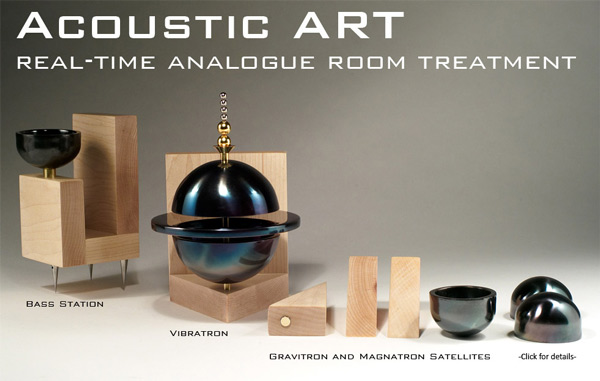At the 2008 Rocky Mountain Audio Fest, I heard a demonstration of the Acoustic ART, a new real-time analogue room treatment system by the Southern California based cable company Synergistic Research. Simply, music was first played with the Acoustic ART system in place and then without. At the strong insistence of the audience, the ART system was reintroduced during this demonstration. I bought the show special on the spot, as did many others.
The Acoustic ART system consists of five specially designed carbon steel resonators, mainly straight-sided bowls that have been specially designed, tuned, and built with the inspiration being Tibetan Prayer bowls. The main resonator, called a Vibratron, looks much like the planet Saturn and mounts on the wall behind your main speakers 4’ to 6’ feet above the floor. The Bass Station on its special base goes on the floor under the Vibratron, 3” to 6” out from the wall behind your speakers with its wooden baffle blocking your view if its resonator satellite and its razor sharp stiletto spikes screwed in place. The rear Satellite, called a Gravatron (due to the fact its satellite resonator is held in place by good old fashioned gravity), mounts 2/3 to 3/4 of the way up the rear wall behind your listening position. Two Satellites called Magnetrons (due to their magnetic base that holds its steel satellite resonators in place) mount on the left and right sidewall at or just behind the first reflection point about 3-5” above the Vibratron.
Placement of these, in my experience, is most critical and is made easier when you have a friend hold a small mirror along the sidewall in front of your speakers. As your friend moves the mirror along the wall, from your listening position, look for the reflection of your main speakers tweeters. When you see the tweeter from the speaker nearest the side wall, you’ve found your first order reflection point and the starting point for Magnetron Satellite placement. The Magnetron Satellites ultimately influenced my moving source equipment in my room from the first order reflection point on my left wall, and record cleaning equipment from the first order reflection point on my right wall, to a location more (acoustically) out of the way.
The Acoustic ART system does take some time to achieve the best results, but most will not have to move equipment as I did. Getting Blu-Tac to hold the various bases to the wall rather than other wall adhesives, I tried, is a must. I understand current kits include it. Because the Vibratron weighs considerably, it is suspended with a hook from a nail.
If you want to hear the effect of the Acoustic ART system once you have incorporated it into your system, you can do what was done in the RMAF demonstration, namely remove the metal satellite resonators from their stands, turning them upside down (so they don’t resonate) and placing the Vibratron on a pillow (also to prevent it from resonating). At the demonstration, and in my room, once I had finalized adjustment and positioning of the Acoustic ART System components, as soon as the metal satellite resonators are removed from their bases, my sound stage collapses, the leading edge on transients dulls, the bass bloats, the treble loses its sheen, and your walls close in. Other than that nothing changes.
There is a question about other room treatments. I was told at the RMAF that they are largely irrelevant to the Acoustic ART effect. I did not find that to be the case, and I have removed my Shakti Holographs, most of my Shun Mooks Mpingo disks, Brilliant Pebbles and one of my Acoustic Revive QR-8 dots. Others have told me the Holographs continue to have a benefit in their rooms, but that was not my experience. Please note that I have no experience with digital room corrections and how they might interact with the Acoustic ART System.
In many ways, the Synergistic Research ART System is unobtrusive, at least relative to larger room correction devices, such as corner tube traps and bass traps, Room Lens, or Holographs, but the Vibratron does draw attention. When my Magnetron Satellites were raised above equipment or behind it, I did not experience the same benefit that I heard in the demonstration or what I ultimately got when I moved equipment from my side wall first order reflection points.
I have experimented with many different room treatments from LEDE, etc. Some have given me substantial improvements, such as the Shakti Holographs, but none has been so overwhelmingly beneficial. In fact, after I reported what I heard to a doubting group at breakfast the day after my experience in the RMAF demonstration, they made their way to the Synergistic Research Acoustic ART demonstration and all but one bought show specials, even though some are quite frugal.
Recommended.
- (Page 1 of 1)

Pingback: Hifiutstyr og kabler uten dokumentert effekt, er markedsføringen lovlig? - Side 63